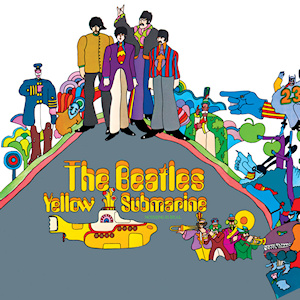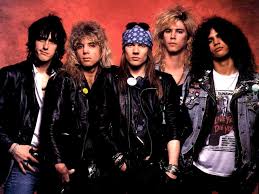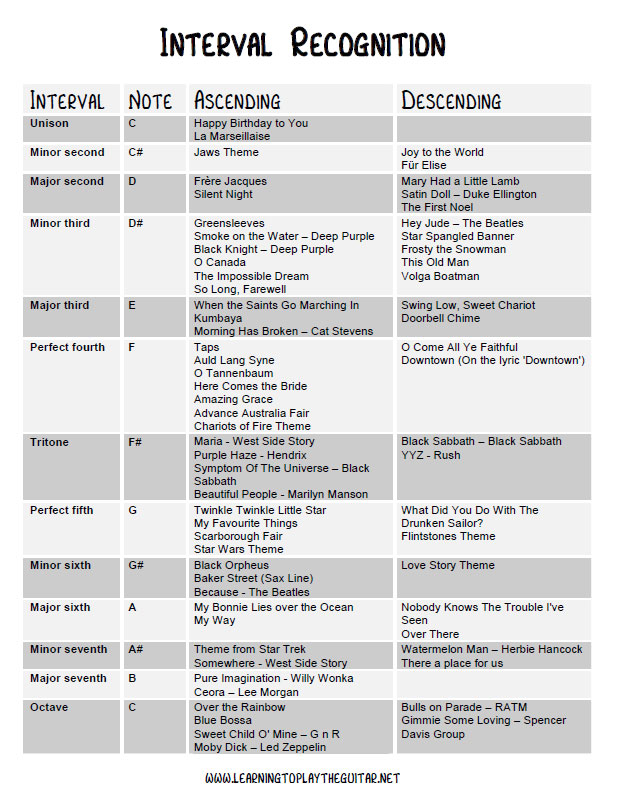How To Transcribe Music By Ear
Learning how to transcribe music by ear whether it’s the chords, a riff or guitar solo from a song is a great exercise in developing your ear and aural skills. Many famous musicians and guitarists have had this ability including Steve Vai, Stevie Wonder, Yngwie Malmsteen, Pat Metheny, Jimi Hendrix, Mozart and many others.
Transcribing Chords
In this guitar lesson we will learn how to transcribe music. When transcribing songs one of the most important elements are the chords. The two main types of chords in music are Major and Minor chords. Major chords have a bright happy sound while Minor chords have a darker sad sound.
|
Major & Minor Chords | Download |
So apart from knowing if it is a Major or Minor chord you will also need to know the pitch of the chord. For example is it G D E or A major? One simple way to work that out is to listen to the bass note of the chord.
To find this bass note playback the part of the song which has the chord you’re trying to learn. At the same time play along with just one note up and down the 6th (thickest) string of the guitar until you hear the note that matches the bass note of the chord. It may take a few repeated playbacks of the chord with your guitar note until you find the note that matches.
To make this process of repeating individual chords of a song easier you can use music transcribing software such as Transcribe! by Seventh String. This transcription software allows you to highlight and loop sections of a recording or mp3 file.
Transcribe! also allows you to slow down the audio which helps to work out chord progressions and notes. We will look at this a bit later on.
Using audio software like Transcribe! set the playback to loop the chord you want to work out while you play up and down the 6th string until the bass note sounds the same. A clue in finding the correct note is that the wrong notes either side (1 fret up & down) of the correct note will sound very wrong.
|
Finding The Bass Note of a Chord | Download |
Transcribe! music software also has a karaoke feature enabling you to remove the vocals so you can just hear the guitar parts.
It also has an EQ/Filter control to remove the distracting high notes so you can just focus on the bass note which can help in finding the bass note of the chord too.
Once you have the right pitch you have to determine whether it’s a Major chord (happy) or Minor (sad) chord.
|
Finding The Major or Minor Chord | Download |
Of course there are other types of chords including Dominant 7th, Major 7ths, Minor 7ths, Diminished and Augmented chords. However here we will keep things simple with just look at Major and Minor chords.
Again using audio software like Transcibe! loop the chord on the recording while playing Major and Minor chords on your guitar until you hear which one matches.
To work out the other chords in the song simply repeat the process until you’ve learnt the whole chord progression by ear.
This chord transcribing method works well for simple songs such as:
 Bad Moon Rising by Creedence Clearwater Revival
Bad Moon Rising by Creedence Clearwater Revival- Heart of Gold by Neil Young
- Knocking on Heavens Door by Bob Dylan
- To Her Door by Paul Kelly
- Yellow Submarine by The Beatles
- Boulevard of Broken Dreams by Green Day
- Riptide by Vance Joy
With these songs the chord rhythms and changes are clear and easy to hear by ear.
Transcribing Riffs
While the chord transcribing method works well for simple songs such as above it won’t work for transcribing music in more complicated songs. As previously mentioned there are other types of chords (e.g. Dominant 7, Diminished etc.) and some guitar music is more riff (single melody note) based such as the music form band like Led Zeppelin and Metallica etc.

Heavy and hard rock music is often a mix of power chords and single note riffs played with distorted and overdriven guitars. These notes will often be played much faster than the chords strummed in a simple Bob Dylan song. When transcribing this music the focus will shift from learning chords to learning single notes.
As in the previous chord example using audio software such as Transcribe! makes transcribing easier by enabling you to loop groups or individual notes from the recording to work them out.
Have the note playback looping while you play up and down the 6th string until the notes sound the same. Sometimes the notes will be fast and short so to hear the pitch more easily Transcribe! has a slow down control to lengthen the playback of individual notes to hear them more easily.
Download Transcribe! – The Music Transcription Software
Recommended by Pat Metheny & Dweezil Zappa!
|
5 Note Loop Slowing Down | Download |
As in the previous chord transcription example the wrong notes either side (1 fret up & down) of the correct note will sound very wrong which will help in finding the correct note. Some notes in a riff may also be higher in pitch so you may need to try search for the note on the 5th, 4th or 3rd strings.
Again you repeat this process for each note until you have the riff transcribed. However this can be a tedious and time consuming way of transcribing a song. Luckily there are a few techniques you can use to speed up the transcription process.
Using Intervals
When you hear 2 separate notes the change in pitch between them is called an Interval. Some intervals go up (ascending) in pitch and some go down (descending). So if you can hear that the 2nd note goes up in pitch compared to the 1st note you have an idea of which direction to go on the guitar neck to find it. Pretty simple!
You can actually train your ears to hear the different intervals. One of the best ways to do this is to associate an interval with the 1st notes of a guitar riff or melody you may know. For example the interval of an ascending Minor 3rd is the first 2 notes of the riff from Deep Purple’s Smoke on The Water. These notes don’t have to be the exact same pitch as the 2 notes of the original riff but the interval relationship between them will be the same.
|
Minor 3rds | Download |
Below is a table showing the intervals and some common melodies and riffs that match. The table also shows the notes based starting on the note C. The major and perfect intervals are from the major scale while the minor intervals are from the minor scale.
If you’re looking to improve your ear and aural skills to learn how to hear intervals and chords better check out the Pitch Master Pro Training Program.
 Using Music Theory
Using Music Theory
Another technique that’s useful in helping to transcribe riffs and melodies is to use your music theory knowledge or to be more specific your knowledge of scales and key signatures.

Most rock music uses the pentatonic scale which is a 5 note scale that comes from the blues. Hard rock music from bands including Black Sabbath, Deep Purple, Guns n Roses, Led Zeppelin, Metallica and more frequently use this scale. So if you can learn the key of a song by ear you will have a fairly good idea of what many of the notes in the tunes will be.
To learn the key of a song work out what the last chord of the song is. Sometimes this isn’t easy if the song fades out or changes key in the middle but many songs have a definite ending on the root chord which is the same as the key (e.g. G major). The root chord sounds like going home to your ears where everything feels complete, comfortable and rested. Use the chord transcription techniques described previously to work out the final/root chord.
Many rock songs are in E minor:
- Paranoid by Black Sabbath
- Enter Sandman by Metallica
- Purple Haze by Jimi Hendrix
- Whole Lotta Love by Led Zeppelin
This means that the riffs in these songs are likely to be based around the notes in the E minor pentatonic scale (E, G, A, B, D).
This will help to eliminate a lot of the guess work as you can ignore the other notes that aren’t in the scale. Armed with this knowledge see if you can work out the notes of the riffs in these songs. Some of the notes in the songs may be outside the scale but most of them will be from it.
Other songs will use the Major Pentatonic Scale which has a country sound (Take It Easy by The Eagles) or even the Major Scale (Sweet Child O Mine main riff by Guns n Roses).
By combining your interval and theory knowledge you will be able to filter out and eliminate the wrong notes more easily. This will ultimately enable you to learn and transcribe the notes of a guitar riff or melody more quickly.
In this guitar lesson we’ve learnt how to transcribe music including the chords to basic songs and the notes of guitar riffs and melodies. Using music transcribing software such as Transcribe! to loop and slow down recordings while applying a knowledge of intervals and music theory will enable you to transcribe all types of guitar music quickly and easily.
Like all aspects of being a musician you can train and improve your ear, aural and transcription skills through practice. So the more music you transcribe the better you will get. Transcribing also helps to train your ears for other music situations including improvising and song writing. It can even help to improve your singing skills as your sense of pitch will improve immensely.
If you’re looking to improve your ear and aural skills check out the Pitch Master Pro Training Program.Following this program will help to train your ears to improve your transcription skills further.






